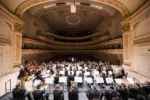Conductors. In Ukrainian: Krotyk
S.Lyudkevych Concert Hall
190–390

Conductors. Ukrainian is already a well-known project of the Lviv National Philharmonic, founded in 2020.
Thanks to the project, young and talented musicians from different parts of Ukraine have the opportunity to loudly announce themselves to the whole world, because all the project events are broadcast online. Ukrainian trampoline masters perform with one of the oldest and most famous Ukrainian ensembles, the Lviv National Philharmonic Symphony Orchestra.
Thanks to such artistic tandems, powerful symphonic programs combining Ukrainian and European music are “born”.
Artists:
- Bartłomiej Tełewiak, violin (Poland)
- Lviv National Philharmonic Symphony Orchestra
- Oksana Krotyk, conductor
Program:
- Franz Liszt – Symphonic Poem Les Préludes (1854)
- Béla Bartók – Violin Concerto No. 1 (1908)
- Felix Mendelssohn – Symphony No. 3 “Scottish”, Op. 56 (1829)
“What else is life but a series of preludes to that unknown song, the first solemn note of which is sounded by Death? Love is the enchanting dawn of all existence, but what is its destiny? Whose early joys have not been interrupted by storm, whose beautiful illusions have not been scattered by the death-dealing blast which destroyed the altar of love as if struck by lightning? And who, having been cruelly wounded, does not seek solace in the calm and carefree peace of rural life once the storms have passed?
Yet man is not long consoled by the blissful warmth he first felt in nature’s lap. So when the trumpet calls to arms, no matter what battle awaits, only struggle restores strength, awareness, and self-control,” — inspired by the words of French poet Alphonse de Lamartine, Hungarian Romantic Franz Liszt described his third and most famous symphonic poem Les Préludes. It will open the evening’s concert performed by the Symphony Orchestra of the Lviv National Philharmonic under the baton of Oksana Krotyk. The romantic spirit will continue with Felix Mendelssohn’s Scottish Symphony No. 3. Unlike the life journey reflected in Liszt’s Les Préludes, Mendelssohn was inspired to write the symphony by a real-life walking tour among the Scottish cliffs and the ruins of Holyrood Chapel, where Mary Stuart was crowned. In this work, young Mendelssohn captured not only echoes of great historical events but also local color, such as the “Scotch Snap” rhythm found in Scottish country dances.
Completing this romantic panorama is Béla Bartók’s Violin Concerto No. 1, discovered posthumously. For 50 years, the concerto lay hidden in the drawer of Hungarian violinist Stefi Geyer, to whom it was dedicated. Having renounced Bartók’s affection, she kept the concerto a secret until her deathbed. According to researchers, the work serves as a musical portrait of their relationship.


